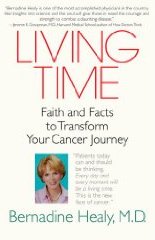
Dr. Bernadine Healy, cancer survivor, physician, and author, at home in Cleveland with husband Dr. Floyd D. Loop
Charlie Archambault for U.S. News & World Report
For many patients today, a cancer diagnosis no longer represents a death sentence. Many types of cancer are achieving the status of chronic but treatable diseases. Earlier detection and better treatments are extending the lives of cancer patients as never before.
As Julia Rowland, Ph.D., director of the NCI Office of Cancer Survivorship, and her colleagues stated in a recent research journal: "In the last three decades, cancer has been transformed from a fatal disease to one in which the majority of people diagnosed with cancer receive highly effective treatments that result in either cure or long-term survivorship."
This message of hope is a hallmark of the latest advances in cancer research by NIH's NCI and the many NCI-funded researchers across the nation.
That is also the message from Bernadine Healy, M.D., former head of the NIH, American Red Cross, and American Heart Association, who suffered a malignant brain tumor eight years ago. In her new book, Living Time: Faith and Facts to Transform Your Cancer Journey, Dr. Healy assesses the current state of cancer research and treatment from both a professional and deeply personal perspective.

"Cancer used to be viewed as a certain death sentence, and that was exactly how I viewed my prognosis on that night in 1999 [when diagnosed]," writes Dr. Healy. "But nowadays we have a new outlook on cancer, and it's a veritable sea change … For most on cancer's path, it is no longer the end of life but the beginning of life's challenging next stage."
So promising is the outlook on living with cancer that there is a new concern: People who have cancer are living long enough now to develop additional tumors, new cancers, as they go forward. Dr. Rowland and her colleagues now estimate that there are 756,467 people diagnosed with more than one primary cancer across an entire lifetime in the United States.
"White women experience the highest burden of both multiple tumors, as well as single tumors," they write. "Breast, colon and rectum, and prostate are the sites with the highest prevalence of multiple tumors."
Dr. Rowland notes that today's researchers and clinicians are coming to understand that survivorship brings a variety of challenges, including those caused by different cultural, racial, and sociodemographic factors. "Among the biggest challenges we have for the future," says Dr. Rowland, "are to better understand the causes and consequences of cancer-related health disparities, and to find ways to eliminate them."
